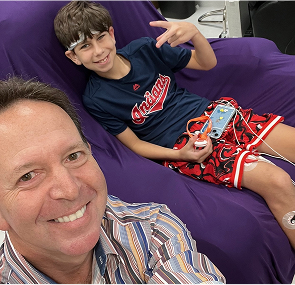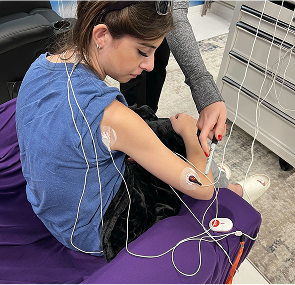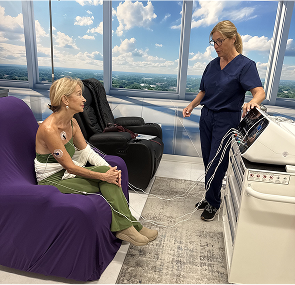Scrambler Therapy for Chronic Migraine and Nerve-Related Head & Neck Pain
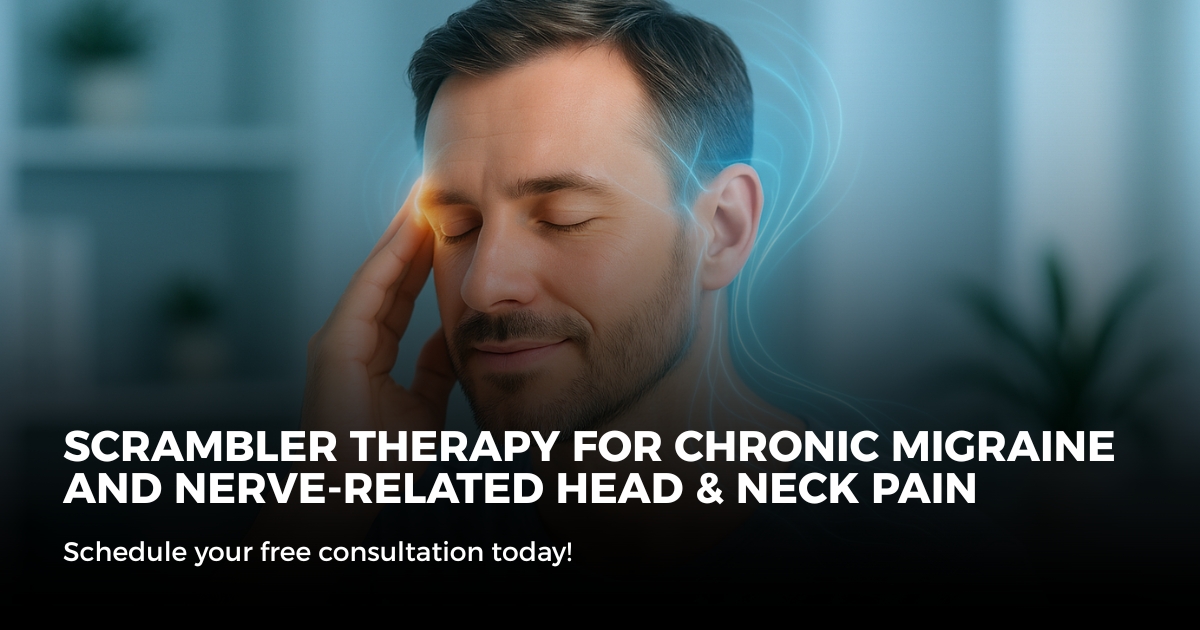
Chronic migraine is a neurological condition that causes headache symptoms 15 or more days a month. In contrast, episodic migraine appears less than 15 days monthly. Migraine becomes chronic when it lasts over 3 months and leads to significant disability.
Common triggers and symptoms of chronic migraine include:
- Photophobia (light sensitivity)
- Aura (visual disturbances)
- Allodynia (pain from non-painful stimuli)
- Throbbing pain, often on one side
- Nausea and sound sensitivity
Neuropathic pain in the head and neck often involves the cranial nerves. Common types include:
- Trigeminal neuralgia: Sharp, electric-like face pain
- Occipital neuralgia: Pain at the back of the head and upper neck
- Cervical plexus involvement: Pain from compressed nerves in the neck
- Myofascial trigger points: Tight muscle bands causing referred nerve pain
Migraine-related nerve pain is often persistent and hard to treat. It becomes entrenched in the nervous system due to neuroplastic changes and cortical sensitization.
Next, we’ll explore how a non-invasive, drug-free treatment—Scrambler Therapy—offers new hope.
What Is Scrambler Therapy?
For persistent nerve pain, the FDA has approved Scrambler Therapy as a non-invasive treatment. It uses a device—such as the Calmare® system, developed by Delta Research & Development—that reprograms how the brain interprets pain signals.
How Scrambler Therapy works:
- Sends non-pain “scrambled” signals through surface electrodes
- Mimics normal nerve impulses using artificial neuron technology
- Targets C-fibers responsible for transmitting chronic pain
- Overrides pain signals at the peripheral nervous system level
The therapy uses a process called neuromodulation, meaning it alters nerve activity without drugs, needles, or invasive procedures.
This pain signal replacement therapy does not block nerves or dull sensations; instead, it replaces pain messages with synthetic "no pain" signals.
Now, let’s see how this approach specifically affects migraine pathways.
How Scrambler Therapy Works for Chronic Migraine Sufferers
Scrambler Therapy modulates the trigeminal nerve and reverses chronic migraine sensitization. Migraine pain becomes chronic through a process known as migraine chronification—where the brain forms a memory of pain.
Scrambler Therapy helps by:
- Disrupting the trigeminal pain pathway
- Reversing pain memory in the dorsal root ganglion
- Promoting nociceptive modulation without pharmaceuticals
- Stimulating serotonin regulation in pain centers
Through neuroplastic reprogramming, it re-teaches the brain to interpret pain signals correctly. This can reduce or eliminate long-term migraine symptoms and improve quality of life.
Patients often experience relief after just a few sessions, and many report reduced dependence on medications.
In the next section, we examine how this therapy also benefits those with nerve-related head and neck conditions.
Nerve-Related Head & Neck Pain: Why Scrambler Therapy Is Ideal
Scrambler Therapy is effective for nerve syndromes like occipital neuralgia, cervical radiculopathy, and facial neuropathy.
These conditions involve:
- Greater occipital nerve compression
- Facial nerve injury or dysfunction
- Cervical nerve root irritation (radicular pain)
- Postherpetic neuralgia from shingles
Scrambler Therapy benefits:
- Reduces neuropathic flare-ups and burning sensations
- Eases nerve compression pain
- Helps with cervicogenic headaches from neck dysfunction
- Targets dermatomal pain zones in the scalp, face, and neck
Unlike nerve blocks or long-term medications, Scrambler is drug-free, pain-free, and repeatable without diminishing results.
Let’s now explore the scientific evidence behind these benefits.
Clinical Evidence: Studies Supporting Scrambler Therapy for Chronic Pain
Clinical trials show Scrambler Therapy reduces pain scores in patients with migraines and neuropathy.
A meta-analysis in PubMed found that over 70% of patients reported significant pain reduction. Studies from the NIH and Pain Management Journal confirm:
- Reduction in pain intensity by up to 80%
- Improvement in quality-of-life metrics
- Lasting relief after 10–12 sessions
Notable studies:
Some studies note limitations in long-term data and sample diversity, but overall results are promising for migraineurs and nerve pain patients.
Now, how does Scrambler compare to other treatments like Botox or TENS?
Comparing Scrambler Therapy with Other Migraine & Nerve Pain Treatments
Scrambler Therapy is often compared to:
- Botox injections
- CGRP inhibitors
- TENS units
- Triptans and opioids
- Acupuncture
Side-by-side comparison:
Scrambler stands out as a sustainable, drug-free option with low risk of rebound or dependency. Next, we walk you through what to expect in a typical therapy session.
The Scrambler Therapy Process: What Patients Can Expect
Each Scrambler session is:
- Outpatient and non-invasive
- Lasts around 45–60 minutes
- Painless, with a mild tingling sensation
The treatment steps:
- Screening by a pain specialist
- Patch placement based on pain mapping
- Device sends analgesic signals
- Monitored by a trained technician or physical therapist
- No recovery time needed
Patients usually undergo 10–12 sessions over 2–3 weeks. You don’t need to stop your regular activities and no side effects are expected.
Now, who’s eligible for this therapy?
Who Qualifies for Scrambler Therapy for Chronic Migraine and Nerve Pain?
Not all patients are candidates for Scrambler Therapy. Eligibility depends on diagnosis, duration of pain, and general health.
Good candidates:
- Diagnosed with chronic migraine or neuropathy
- Pain lasting more than 3 months
- Failed or sensitive to medications
- No pacemaker or seizure history
Screening factors:
- Comorbidities such as uncontrolled diabetes or epilepsy
- Insurance approval status
- Age (typically 18+)
A pain clinic will conduct a medical evaluation and determine your treatment candidacy.
Let’s now look at the safety data.
Side Effects & Safety of Scrambler Therapy
Scrambler Therapy has a strong safety profile and is cleared by the FDA for chronic pain treatment.
Reported side effects:
- Mild skin irritation at electrode sites (rare)
- No dependency
- No sedation or systemic effects
Compared to medications, Scrambler Therapy avoids:
- Rebound headaches
- Organ toxicity
- Tolerance build-up
Pain clinics rate it as a risk-free, discomfort-free therapy for chronic migraine and nerve pain.
Let’s now see how real patients respond to it in real-world scenarios.
Real-World Patient Outcomes and Testimonials
Patient testimonials consistently highlight pain reduction and quality-of-life improvements.
Common outcomes:
- Improved daily function
- Reduced or eliminated pain medication
- Long-term pain relief
- Emotional benefit from reduced suffering
Example: A 42-year-old migraine patient reduced her attack frequency from 20 days to 4 days per month after 10 sessions. Another patient with occipital neuralgia reported complete pain remission for 8 months post-treatment.
Clinics often use pain diaries to track changes, showing clear before-after data.
Now, here’s how to access this treatment.
Accessing Scrambler Therapy: Where & How to Get Treated
To start Scrambler Therapy:
- Find a certified provider via clinic locators
- Request a referral from your physician
- Schedule a telehealth assessment if needed
Cost and insurance:
- Covered by Medicare and some private plans
- Average cost per session: $250–$500
- 10–12 sessions typically required
- Check for reimbursement codes
Pain clinics across the US and globally offer this therapy. Some provide in-network options to lower out-of-pocket costs.
Now we’ll answer some of the most searched questions on Scrambler Therapy.
FAQs: Scrambler Therapy for Chronic Migraine and Nerve-Related Head & Neck Pain
Does Scrambler Therapy help migraines?
Yes, it reduces migraine frequency and pain intensity by modulating trigeminal nerve pathways.
How fast does Scrambler Therapy work?
Relief often begins within 3–5 sessions; full benefits appear by session 10.
How many sessions are needed?
10 to 12 sessions are standard for long-term effect.
Is Scrambler Therapy covered by insurance?
Some plans cover it; check with Medicare or private insurer.
Can Scrambler Therapy treat nerve pain in the head?
Yes, it’s effective for occipital neuralgia, trigeminal pain, and facial nerve syndromes.
Experiencing Chronic Pain in South Florida?
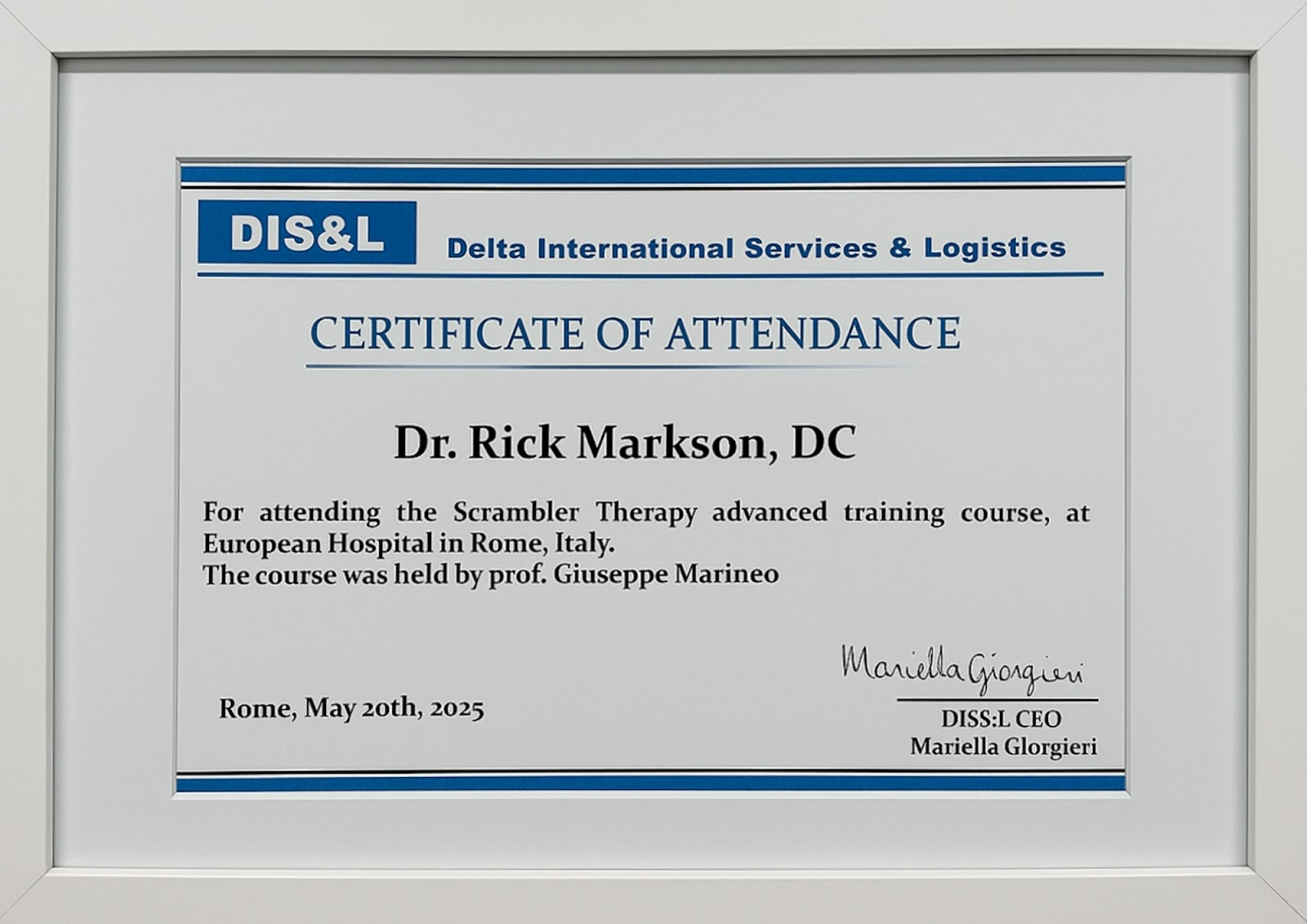
Discover South Florida Scrambler Therapy is one of the nation’s leading clinics for noninvasive chronic pain relief, offering FDA-cleared Scrambler Therapy® for adults and children. Co-founded by Dr. Rick Markson, one of the few practitioners worldwide to receive advanced certification directly from the therapy’s inventor in Rome, our clinic delivers globally recognized expertise with compassionate, personalized care. If you or a loved one is living with treatment-resistant nerve pain, we invite you to schedule a consultation and explore a life beyond pain.
Recommended Reads:
📘 What is scrambler therapy?
📘 What to Expect During a Scrambler Session
📘 CRPS Pain Relief Without Drugs—Real Patient Stories
📘 Conditions that scrambler therapy can treat
Take the Next Step: Free Consultation at South Florida Scrambler
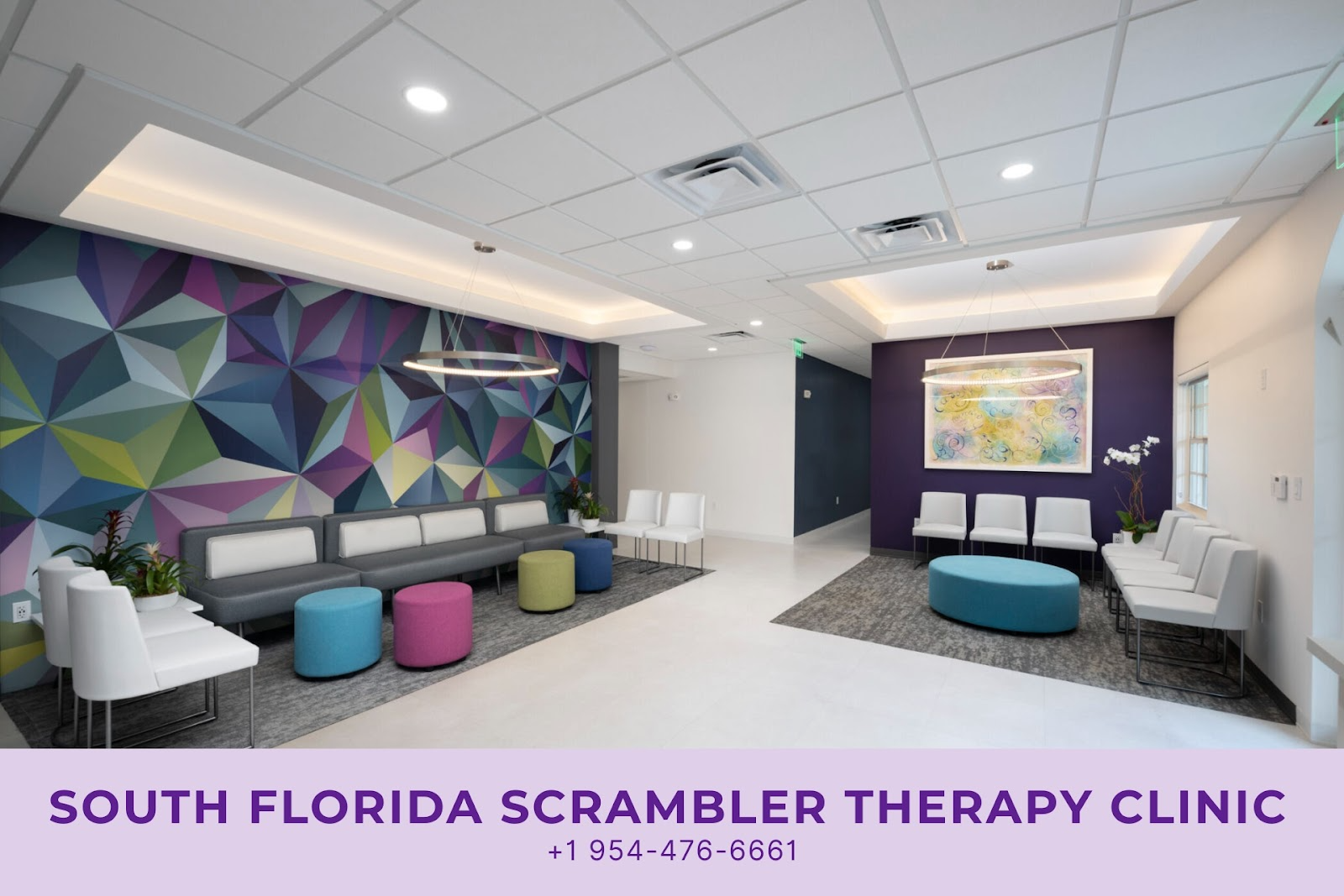
Every day counts when we suffer from chronic pain. South Florida Scrambler Therapy offers a free initial consultation to determine if Scrambler is right for you. Schedule Today:
- Speak directly with Dr. Rick Markson’s team
- Learn about treatment protocols and insurance
- Complete a customized treatment plan
- Start seeing results within days, not months
📞 Call Now or Visit website: www.southfloridascramblertherapy.com
📍 We serve Palm Beach, Fort Lauderdale, and Miami from our location at 100 NW 100th Ave, Plantation
You Can Follow Us through Our Social Media:
📸Instagram—Day-in-the-life stories from our patients
👍Facebook—Success journeys and community support
You deserve to laugh, and enjoy life without pain. The journey starts here.
Start Your Pain-Free Journey Today
